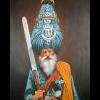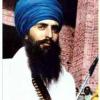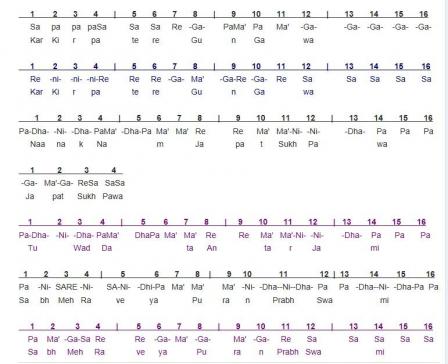Leaderboard
Popular Content
Showing content with the highest reputation on 03/31/2013 in all areas
-
1984 operation bluestar was also an epic battle where just 150 Sikhs armed with stenguns and WW2 rifles kept the Indian army at bay who were armed with all the modern weapons, tanks, helicopters, APC etc. The Sikhs fought as per herioc Sikh traditions.3 points
-
This blog here has started a series on top 20 Sikh battles. It is quite interesting actually. Take a look at the narratives. Top 20 Sikh battles. An almost paradoxical and polarizing statement, especially in face of the fact that Sikhs have been involved in countless battles since time immemorial; which not only highlight their legendary valor but almost supernatural acceptance of death. These 20 battles, however, have been singled out due to the astronomical factors orbiting them. Chamkaur, Sabroan, Manochal are only a few of the names which bring to mind images of astronomical legions facing an almost preposterous number of defenders. The outcome, in these battles, was already evident even before steel clashed upon steel, and cannons fired upon bodies of men, yet in spite of this the Sikh warriors who participated in these battles fought to their last drop of blood and continue to inspire individuals today to face death with a resolute calmness. The world might pay obeisance to one Thermopylae, where 300 Spartans squared off against Xerxes's Persian hordes, yet the Sikh nation has 20 separate Thermopylae's. The First Battle: Chamkaur. Fought in 1705 A.D. The birth of these 20 battles can be pinpointed back to Chamkaur, where a contingent of 40 Sikhs faced the titanically humongous 40,000 strong mughal detachment, sent to pursue their commander-in-chief, and spiritual master, Guru Gobind Singh. The background to Chamkaur is as bloody as it is complex. It was the catalyst of almost two years of warfare involving hundreds of fatalities on both the offending and defending sides. The tenth Sikh Guru, Guru Gobind Singh's, call to arms and the creation of the Khalsa- a militant entity consisting of saint-warriors- had not gone down well with the Hindu monarchs whose principalities bordered his. The induction of victims of political and religious extremism into the Khalsa convinced the monarchs that their way of life was in danger, and the Guru possessed a threat to their suzerainty. They had already measured swords with him before and come out the worst for the wear. To this end they decided to approach their overlord; the mughal emperor Aurangzeb for assistance in curbing what they saw as the Guru's growing revolution. Aurangzeb was already aware of the Guru's revolutionary tenacities and militant spirit combined with a natural charitable nature. The Guru's doors were constantly open to any individual who was persecuted by the state on the basis of his faith or beliefs. To this end Aurangzeb had placed constant surveillance on the Guru. He had had also ordered the execution of the Guru's father, and predecessor Guru, Guru Teghbahadur, who had advocated multi-religiosity and in doing so had defied the state. This and the constant implorements of the Hindu monarchs, convinced Aurangzeb that the Guru was after his own suzerainty despite being aware that the Guru harbored no political ambitions or convictions. To this end he summoned his generals, and soon a combined force of imperial and royalist troops set out for Anandpur, the Guru's stronghold. The Guru however had not been sitting idle during this time. He had been constantly attacked in the early 1700's by royalist forces seeking to evict him from Anandpur, which had been purchased by his father from the King of Assam. Realizing that his foes would now petition Aurangzeb and whip up a frenzy of religious extremism to subdue him, and the Khalsa as a result, he started strengthening the Khalsa forces and his sub-ordinate strongholds. As a result, by the time the joint force arrived in May the Guru was well prepared to enter into combat with them. Anandpur, the central stronghold, was situated on mountainous terrain and the Khalsa exploited this well. It launched a rain of bullets and arrows upon it's foes down below, and the Guru personally lead his fighting forces into hand-to-hand combat, slowly decimating the enemy's best warriors and generals. For more than seven months the Khalsa held out despite suffering from a lack of edibles and scarcity of water. It's ever ready state, along with it's war-like temperament proved too much for even the imperialst's moral who soon started losing spirit. Ultimately a conference was called by the joint nerve center of the mughal-royalist force, and a plan was born. Both Hindu and Mughal officials would petition the Guru, by swearing on the cow and Quran, to evacuate Anandpur. The Guru, who they predicted,would surely accept this and would be attacked as he was leaving and the Khalsa would be permanently decimated. Unbeknownst to them, the Guru had already second-guessed their treacherous maneouvre and by the time their petition arrived was in no mood to leave. He decided to wait out and improvise upon his situation. The Khalsa too supported him in this, and ultimately after forcing the imperialo-royalist force through a nerve-wracking wait decided to leave on the 5th of December, 1705 A.D. Just as the Guru had suspected his treacherous foes attacked him, and in the ensuing confusion the Khalsa attempted to cross the river Sira which was in full spate. As a result the Guru was separated from his main body of 200 soldiers, and his mother and two younger sons. After crossing onto the other side of Sirsa a head count was taken and it was discovered that only 40 warriors were left with the Guru. These 40 also included the Guru's two elder sons and apostolic body, the 'Panj Piares' or five beloved ones. After assessing his situation the Guru lead his charges into a nearby brick dwelling and decided to seek shelter from an impeding storm. Unbeknownst to them however a strong detachment of up to 40,000 soldiers was heavily embroiled in their pursuit and soon had them besieged. With no food or water, and only 40 men with him it was up to the Guru to decide the fate of the Khalsa at this critical juncture. Would he surrender or would he declare combat? He decided to opt for the latter. It is said that when a certain number of generals came to ask the Guru to surrender, his answer was a hail of arrows which soon had them fleeing and declaring an imminent charge on his position. The Guru in the meantime had assessed his situation, his men possessed arrows and a small number of guns. If used properly and sparingly these could inflict heavy casualties on the enemy. Secondly his location was surrounded by high walls, which acted in the same capacity as the fort walls at Anandpur. Not only did they provide a vantage point for him but could also be used as cover for his archers and snipers. His men also carried bladed weapons, which would prove useful in hand to hand combat and thirdly they still retained their horses with them. If it came to charging out into the midst of the enemy and/or making a quick getaway (which at the time seemed impossible) than these would prove quite instrumental. Thus with his capacities assessed and his men readied the Guru alongst with his men launched a tirade of death upon the charging imperialist troops. One also has to take into consideration the battlefield itself. If the imperial generals spread their forces out than only a sub-section would reach the designated target, whilst the others would be thinly spread out and easy picking for a sniper or archer. Thus they decided to crowd their men into lines which would charge the dwelling. They however had not suspected the Guru's resilience and were badly beaten back the first time more so, it seems, due to shock and surprise at the valor displayed by their providential prey. Soon however the Khalsa artillery began to decrease and a decision was taken to start sending out individual platoons to challenge the enemy to hand-to-hand combat. 5 warriors, armed to the teeth, were sent out and their companions in arms waited to see the result of their choice. The awe which the Persians must have experienced at Thermopylae, was also evident in their descendant's faces. Their 5 foes, preposterously, proved to be a strong wall slaughtering imperialists left, right and center Each and every time a soldier tried rushing them he was immediately cut down and trampled upon. With their bloodied beards and bodies, the Khalsa warriors fought with the air of men who carried the desire to marry death. Ultimately this wish was finalized as one by one they began to fall and ultimately not even one remained standing. The awed imperialists once more gathered together and again raced towards the Guru's position. The Guru who had been watching from the top of the structure, and was in an exposed position, shouting out war cries was now approached by his eldest son Ajit Singh. At only fifteen years of age, this son of the Guru had already proven himself as a resolute general and resilient warrior. He expressed his desire to his father that he too wanted to go out into the battle field and measure swords with the enemy, and go the way of his Khalsa brethren. The Guru at the time handed him a spear, mounted him on a horse and with his full blessings sent him with four others, into the midst of the regrouping enemy. Ajit Singh and his companions too proved to be an immovable wall in the face of the enemy, and steadfastly decapitated any soldier valorous enough to step into their path. In the midst of the battle Ajit Singh finally singled out a prominent enemy general, and with all the force he could muster, speared him through the heart and deprived the enemy of one of it's strategic brain cells. Ultimately Ajit Singh too went the same way as his predecessors, and on seeing this the Guru expressed his joy and picked up the tendum with which he was shouting his war cries. By this instance in time the enemy had been pushed far enough back to grant the Khalsa and the Guru a reprieve. Yet this situation lasted only a few moments, soon the imperialist hordes were once more charging towards their target, and the Guru started picking new men to enter the fray. This time his second son, Jujhar Singh, who was only twelve volunteered to enjoin the enemy as his brother had done. The Guru too gave him the same treatment as his brother, and sent him out into battle. Jujhar too bravely fell and by the time dusk eventually came, both sides settled down to wait the night out and re-progress fighting at dawn. Ultimately as they say 'the rest is history.' It will be sufficient at this stage to say that the Guru managed to slip through the grasp of his proclaimed foes, and continued to wage perpetual warfare against their tyranny. What we however must give due credence to is the fighting, and strategic capabilities of the Khalsa warriors. Despite being physically starved of any food or rest, lacking water, and being entrapped in an almost perfectly formed trap they still managed to fight their way out of it. There was no colorful strategy involved in this battle. But the inner convictions and spirits of men who know they will surely die, but want to do so as beacons of resistance. Chamkaur truly changed not only the face of Sikh history, but also world history as no battle before ever involved the astronomical odds which the Sikhs had faced then. http://tisarpanth.blogspot.co.nz/2013/03/top-20-sikh-battles.html2 points
-
That police officer regardless of his religion, race need to be fired and prosecuted for showing misuse of his power.2 points
-
You fellows can speculate about what ever you like, but within the next 50 years the situation most likely to develop is as following: Afghan Jehadis are going to infiltrate into Kashmir. Initially it would be opposed by Pakistan, but only to a small extent. Seeing the success of Afghans in Kashmir, Pakistan will also come to their help, and so will china tacitly. As the conflict heats up, Sikhs will be divided in what to do. Some of them rebel against India and others will stay loyal to India. In this conflict Sikhs will be the biggest losers as for as the loss of life is concerned, and their number will be greatly reduced as to have any political influence for ages to come. Area of present Indian Punjab, Himachal, most of Haryana, and North Western part of Rajasthan will come under Islamic rule with China as their ally on international forum. As for the Sikhs in rest of India, they are going to have untold difficulties for the reason that Sikhs of Punjab rebelled against India.2 points
-
I am sure you guys follow every letter in Gurbani then? Because nothing is more powerful than Gurbani!2 points
-
I'm sure that you aware this is not gurbani although it is Kabirji's work. However, whatever Guruji picked to include of Kabir's in the adi granth is what constitutes to gurbani. I know there is a lot of his poetry available that has similar messages as per gurbani. To understand the above, I think you need to know a little about Kabirji's early life. Basically, he was adopted and spent years under the wing of his brahmin guru -Ramanand. From the years spent their he 'realised' the falseness and blind hindu practices which made him understand 'Gurmat' as per Guru Nanak ji. Now, to answer your question the above - "i saw nothing in chanting Ram, and i saw nothing in books" - ---He's saying that he learned nothing except for the blind prayers and practices. "If there were another God besides You, what would it be? If it were that way, then what would it be? If it were this way, then what would it be?" ---------------These few lines are saying that is Ram the God ? or if not then who is the other God ? He was pretty much clued up about the concept of IK ONKAAR. Because, according to this the God becomes who you make it, so how can you accustom your own God depending on what you need and feel ?? "My lips wont utter Ram, My Ram recites me, I have found peace, Kabira!" ......-----These are very strong few lines that you can only interpret after you have studied Kabirji's other work.- And I really like and admire these. !! What he is saying here is -- That the Ram or God he was looking for and trying to find has instead found him !!! What does this mean ?? -Well, this is what actual ''GOD Realisation'' is. When someone is enlightened and had has really ''Realised'' what God is, then they will tell you that you realise that it wasn't just you looking for God because all that time 'HE' (God) was looking for you as well. So when Kabirji says ''my ram recites me'', - then this is what he means. He goes on further to say ''I have found peace''.- this means I have got the ''GOD-Realisation'' !! These are my own interpretations from what I know and have learned, and I hope they provide you with some assistance and understanding. All Errors are mine and I stand corrected by any other learned members that may contribute.2 points
-
So i was reading the discussion about langar in the other topic and remembered the sakhi of this sikh couple who would do seva in langar and then eat langar every day. I think they were told that langar became like a payment from the guru to them so they were advised not to consume langar all the time. I might be wrong as i was very young when i read that sakhi. Anyway, so in our gurdwaras usually there is langar leftover after everyone has eaten. There is mad rush to fill tomato tins, Tupperware etc with langar to take home. As we know many people are struggling with expenses, should we be promoting langar to non Sikhs? There could be a list of people who sevadars could send the leftover langar. It would be better than us lot overeating langar. We used to do this at our old location, there was an old peoples home nearby and we used to send them the food.1 point
-
On Saturday 13th April 2013 The Sikh Community of Leicester (UK) would like to celebrate Vaisakhi by encouraging the sangat (congregation) to partake in the seva (selfless service) of the poor and homeless. “A poor person’s mouth is the treasure chest of God” and in the spirit of Vand Ke Shako (sharing) we would like to serve the community of Leicester. With increasing government cuts many individuals, families and children are suffering from harsh economic pressures. Leicester has 26,000 children living below the poverty line, according to national figures (BBC News). Furthermore, an increasing number of refugees and asylum seekers are facing extreme poverty. Accordingly, The Sikh Community of Leicester would like to support FareShare, British Red Cross and The Dawn Centre this Vaisakhi. These three local charities are carrying out vital work to help those suffering from poverty. On Saturday 13th April 2013 there will be a ‘Vaisakhi Food Drive’ marquee in the car park of Guru Tegh Bahadur Gurdwara, 106 East Park Road, Leicester, LE5 4QB between 9am-4pm so that people can drop off their non perishable food (“shelf-stable” items that do not spoil or decay therefore they are usually packaged or tinned) items and toiletry donations. Please note that donations must be vegetarian, egg free, alcohol free please. More donation details and contact information is attached on the poster and food drive donation list. Your generosity is greatly appreciated in making this Vaisakhi special for everyone in Leicester. #VFD2013 “A poor person’s mouth is the treasure chest of God” https://www.facebook.com/events/348914738541899/1 point
-
A collection of his writings are in a book, and some of the English translations say this (they're accurate): "i saw nothing in chanting Ram, and i saw nothing in books" "If there were another God besides You, what would it be? If it were that way, then what would it be? If it were this way, then what would it be?" "My lips wont utter Ram, My Ram recites me, I have found peace, Kabira!" These are poems of Bhagat Kabir Ji translated to English. I'm really looking for help in understanding them. Thanks! For more of an idea of where its from, this is the book http://www.google.ca/imgres?imgurl=http://dipti.ragadesign.in/sites/default/files/styles/gallery_img/public/06%2520Ghat%2520Ghat%2520Kabir%2520%257C%2520the%2520kabir%2520project.png&imgrefurl=http://dipti.ragadesign.in/interactive/kabir-project&h=679&w=983&sz=856&tbnid=y9ooiQAhqXJLAM:&tbnh=86&tbnw=125&zoom=1&usg=__2nACSN2efMTvZSCwedm22wHyw4c=&docid=x10Z1JySWWwadM&sa=X&ei=qF1XUdCoIeaIiALq3YCwDw&ved=0CEIQ9QEwBA&dur=1901 point
-
In India there r so many beggars that u dont need to prepare the list nor u need to call them... Everyone comes automatically n nothing is left over....1 point
-
You will become highly constipated for 40 days and 40 nights. To beat this you might immediately hop on one leg while rubbing your tummy and hopping on one leg.1 point
-
Hey don't take offence because I thought the OP was fantastic and even though we know the basic story, I found it very informative and touching to the sense that you imagine a little of what they were really gong through. It's just that Indira's attack was not a battle for volunteered soldiers but an attack on te majority of civilians, basically a massacre.1 point
-
Baba Banda Singh Bahadur was chased by 90,000 thousand muslim soldiers and same number of muslim surrender to a Sikh Gen. Arora in 1971 war with Pak.1 point
-
Well, here you go ! Why are you asking no gooders on here, when you should ring up the named above ? You should ask one of the santji's 'that i' going to do some drugs and mushrooms bhai saab, if you don't let me experienc akaal purakh ?" Stop wasting time on here putting your satanic thoughts into other gursikhs. If you had true darshan, ten these thoughts would not even occur to you. Go read, understand and contemplate some gurbani, then you may realise that your left and right hand can work independently but they are still one !! You can hold out your left hand and wait for God to put a prized good in it, And until he doesn't you can use your right hand to do bad deeds or put it on some filth where it is not supposed to be. Is this your idea of the game of love with God ? Guru Nanak's was about putting his head in either hand and offering it to the Lord, but you are too busy deciding what to play with your damned hands ! Nuff said,....... :stupidme: :cool2:1 point
-
Whenever your kirpan slips off from your gatra do 1 japuji sahib paath and ardas. But remember to do it before drinking or eating anything source: khalsa jeevan by sant gurbachan singh ji.1 point
-
Nothing surprises me when it comes to the us, been on other sikh sites (spn) and the amount of so called us sikhs and there strange views about sikhi, one example is that naam simran or parroting (there words not mine) is of no use !!, They talk alot but thats all i'm afraid.1 point
-
what lol veerji..... u r so brave huh......just for 3 weeks ...u summed up everything ........ most of my life i've lived in india.......and we personally were stopped by police ...coz we had picture of sant ji on the number plate of our bike...they threaten us to remove it....and dey did remove it ..... some of my freinds were rounded up and were put in jail just coz they had bhindranwale posters ....... in their shops n house..... veerji i've seen n experienced all this stuff through out my life....... for ur information let me tell u ........there are so many police intelligent personal who roam around gurughars and bus stands through out punjab ...... n they keep eye on all ppl who buy bhindranwale stuff from shops ...... and for jazzy ... its not me or u to judge him.......... and i'm not saying he is religious .....but compared to most of sikh preachers ...he has guts to support sant ji......1 point
-
Jazzy profits from big indian companies yet has defied them by wearing Jarnail Singh t- shirt, i ve heard his father is relgious though, here he is with him1 point
-
WJKK WJKF I saw this in the link u just put up and dont know what keys to press on the baja plz tell Madh Saptak: sa re ga ma pa dha ni Taar Saptak: SA RE GA MA PA DHA NI Komal sur : -re-, -ga-, -dha-, -ni-, -RE-, -GA-, -DHA-, -NI- 1 2 3 4 | 5 6 7 8 | 9 10 11 12 | 13 14 15 16 SA SA SA -dha- ma -ga- -ga- -ga- SA ni SA SA SA SA ni -dha- Jha garh dang na garh dang ba garh dang ba je 1 2 3 4 | 5 6 7 8 | 9 10 11 12 | 13 14 15 16 -ga- -ga- ma ma -dha- -dha- ni ni SA SA SA ni SA SA SA SA gaa garh dang ga ji ma ha ga j ga je 1 2 3 4 | 5 6 7 8 | 9 10 11 12 | 13 14 15 16 -GA- -GA- -GA- -GA- -GA- -GA- MA MA -GA- -GA- SA ni SA SA SA SA gaa garh dang ga ji ma ha ga j ga je1 point
-
1 point
-
Mandar Saptak: sa re ga ma pa dha ni (all lower case) Madh Saptak: Sa Re Ga Ma Pa Dha Ni (Initials upper case) Taar Saptak: SA RE GA MA PA DHA NI (all upper case) Komal sur : -re-, -ga-, -dha-, -ni-, -Re-, -Ga-, -Dha-, -Ni-, -RE-, -GA-, -DHA-, -NI- Ma teevar : ma' Ma' MA' 1 2 3 4 | 5 6 7 8 | (Sa dha) dha (dha Sa Sa) (Sa Re) (Re Ga) Ga Ga Re Pra n Ke B chai ya Dhoodh Pu- 9 10 11 12 | 13 14 15 16 Re (Ga Re) Sa Re Ga Ga Ga Re -t Ke Di wai ya Rog So 1 2 3 4 | 5 6 7 8 | Ga Re Re (Sa ni) dha dha Re Re G Ke Mitai ya Kidhu Ma 9 10 11 12 | 13 14 15 16 Ga Re Sa Re Re Sa Sa Sa Ni Maha Ma- -an Ho 1 2 3 4 | 5 6 7 8 | Pa Pa Pa Dha Dha SA SA SA Nir ju r Niroo- -p Ho Ke 9 10 11 12 | 13 14 15 16 SA RE (RE GA) SA RE (RE SA) SA Ni Sun- -d- -r Sa- -roo -p Ho Ke 1 2 3 4 | 5 6 7 8 | Ni Ni (Ni SA) Dha Pa (Ma Pa) (Ma Ga) Dha Bhu- -p- -n Ke Bhu- -p Ho Ke 9 10 11 12 | 13 14 15 16 Pa Dha (Pa Ma') Pa Pa Pa Pa Pa Da- -ta Maha Da- -n Ho Whilst going back down to the asthaee | 13 14 15 16 (Pa Ma) (Ga Re) (Ga Re) Sa1 point
-
I shall start with explaining a little about Saptaks which might make it easier to understand the notations. Madh : middle Sapt : 7 Saptak: containing 7. It's technically an octave....but in Indian classical music the last Sa belongs to the next saptak. Also, the literal translation of an octave would be 'ashtak'. So, doesn't make much sense there. An image about saptak on Harmonium. Mandr : lower (dunno if that's the literal meaning) Taar : higher ( " ) The above picture shows the saptaks very well but a horrible depiction od komal and Ma teevar sur. Usually the Mandr saptak keys are denoted with a dot beneath them and the Taar saptak keys with the dot above them. But then again, it's in English. Compare the image below to the one above to see the way octaves can be moved around according to the Sa you choose. The followinf images are a Punjabi notation, from the website of Jawaddi Taksaal and shows a bit how keys are normally written. Simple explanation for Ma teevar sur: When all the shudh(pure/normal) keys and Komal keys are marked, there is only one left, right next to Shudh Ma. That is a Teevar Ma. Now, one might ask why this is Teevar and the other Komal. In this case, Teevar : slightly higher Komal : slightly lower (komal = soft) This video explains a bit about the sargam and how Sa can be changed accoording to the scale you want to sing on. Hope this helps a bit :smile2:1 point
-
Waheguroo - some amazing pics here Especially of the one of Sant Jarnail Singh Jee with Sant Jagjit Singh Jee :s1 point















